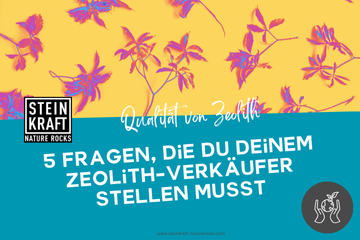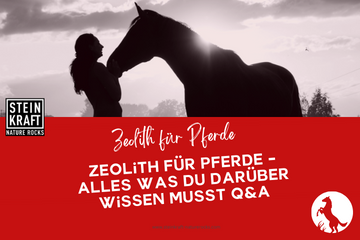FRAGEN UND ANTWORTEN ZU ZEOLITH
What is ZEOLITE-AIR2AIR TECHNOLOGY and how does it work?
...yes, this pulverization method makes all the difference. This innovative advance (the development of the AIR2AIR Activation Technology took several years) then delivers finely pulverized and activated zeolite. And this is a physical process. The particles are catapulted against each other at high speed and begin to charge. The collision causes a shift in the centers of gravity. The negative charges are concentrated on the particle surface, and the positive ones inside. But I also like my father's idea: he says that the zeolite, which was once hot lava, then cooled in water (this is how the small channels inside were formed – the stone absorbed water, and this water then evaporated), then turned into stone, contains all forms of energy within it: fire, air, earth... And when it is then pulverized (here the surface is enlarged so that as many channels as possible are open and can act like a sponge, attracting the positive pollutants), it remembers its full potential and makes it available. Purely physical, then.
We consider it much more important that with this method, which can also be called tribomechanical, we pulverize without abrasion. Therefore, the basic energy and purity of the zeolite are very high. Normally, grinding is done with ball mills capable of up to 90µm. With high energy input, they can then grind down to 50µm. And you can imagine how long this mill has to grind and how much abrasion is already in the zeolite.
What are the advantages of the tribomechanical grinding process and the AIR2AIR Activation Technology?
What can be achieved with zeolite through the tribomechanical grinding process?
1. Can pulverize different grain sizes
2. No abrasion, therefore high purity
3. Activated physically
4. Greater effectiveness
5. Internal structural grids (cavities) are not crushed
What is special about STEINKRAFT zeolite?
Here is a summary of the benefits of our zeolite:
- AIR2AIR Activation Technology grinding process – a further development of airflow grinding (tribomechanical). Zeolite is pulverized without abrasion, ensuring the highest purity. Our products DOGKRAFT and CATKRAFT are pulverized to 14 µm [d50], HORSEKRAFT to 24 µm [d50], and LIFEKRAFT to 8 µm [d50].
- Ball mills are traditionally used, which automatically results in metal abrasion and contamination of the base material. Ball mills can grind down to 90 µm. And often, coarser grinding is used, which means significantly more zeolite is needed to achieve a good effect.
- Europe's best mining site, certified careful mining, and selective raw material extraction. How and where zeolite is mined is important. We examined and evaluated all raw material sources in Europe and then made our decision. Our raw material comes from Eastern Slovakia and is not blasted. Blasting is often used for mining, which can lead to impurities in the base material and cross-contamination through storage and transport with other materials.
- Research advantage and therefore continuous refinement.
- 100% pure without additives, 100% natural and vegan.
- Some offer blended zeolite or industrial zeolite, sometimes even diluted with other substances. It's important to us that everything is sourced from a single source—directly from production, meaning we see how our zeolite is milled.
- Engineered and manufactured in Austria – high Austrian quality standards. Zeolite is often found on the market with uncertain quality standards regarding origin, processing, and transport, and processes that lack transparency.
- Energetically charged through the milling process and according to Grabovoi's methods. And we mill with the moon!
- The best treatment of this great active ingredient is a matter close to our hearts.
How long does zeolite last?
Does zeolite have an expiration date?
Zeolite is a volcanic mineral, meaning it's quite old and rocky, so it has an infinite shelf life. The powdered form should be stored in tightly sealed containers. Zeolite is hygroscopic—it attracts water and pollutants from the environment. As a technological feed additive, zeolite requires a shelf life according to feed law. We've opted for two to five years.
How do I recognize quality zeolite?
Criteria for the quality of zeolite:
1. Where does the raw material come from? And how is zeolite mined?
There aren't many zeolite mining sites. In fact, there are none in Austria, and there are no zeolite deposits in Germany either. The first thing to know is that different mining sites have different zeolite compositions. This means that zeolite from Turkey, Romania, Poland, Ukraine, Norway, Cuba, Slovakia, etc., has different mineral compositions.
Over the past decades, my father and brother have carefully examined all raw materials (except those from Cuba), analyzed them, and monitored the mining methods. For STEINKRAFT zeolite, we clearly opted for the raw material from Kosice in eastern Slovakia.
There are several reasons that are crucial for us:
Criteria for STEINKRAFT Zeolite:
Composition and mining method
the composition of the mineral,
the high silicon content and
The high clinoptilolite content. At this mining site, raw material extraction is selective and carried out by an Austrian company; and it's not blasting, but scraping! We like that. This means that the raw material is not contaminated by blasting, thus preventing cross-contamination. During mining, high quality standards that meet Austrian standards are maintained at the mining site.
Danger
You should be especially alert if zeolite offers do not disclose the source or are described vaguely. The Carpathians, for example, are a long mountain range that stretches across several countries. There are several deposits here with very different qualities. Decide for yourself whether you want zeolite from Poland, Romania, Ukraine, or Turkey, or select a zeolite that meets the qualities described above. Prof. Dr. Hecht, the international zeolite expert, recommends the mining area in Kosice, eastern Slovakia.
2. The grinding method for zeolite is particularly important - it MUST be tribomechanical
Conventional grinding processes are carried out using ball mills. We'll be looking at a wide variety of ball mills again and again. Ball-like shapes of different sizes made of different metals (very often lead and iron) grind the minerals. They are rubbed against each other until the raw material reaches the desired fineness. Such balls have to work for quite a long time until a fineness of 50 microns is achieved. These balls (sometimes also discs) must be replaced regularly because of the high level of metal abrasion that occurs.
And where does this abrasion go during grinding? Zeolite attracts metal, so the abrasion is absorbed by the zeolite and contaminated. At the same time, the internal crystal lattices are crushed during this grinding process. The effectiveness of the zeolite is thus minimized.
My brother always explains it with a Maltesers ball (you know, those airy pastries covered in chocolate): If you ground them, the inner cavities would ultimately be crushed and thus sealed. We don't have any of that with our STEINKRAFT products thanks to our special TRIBOMECHANICAL air pulverization (Air2Air): the crystal lattices are preserved, opened up even more, the effectiveness is increased, and the zeolite is pulverized finely and without abrasion.
CONCLUSION: Non-blasted zeolite tribomechanically micronized produces products of high purity with even higher basic energy (Bovis) - and a very good feeling.
What is the optimal grain size for zeolite?
Understanding "Ultrafine" in Zeolite Products
Many zeolite products are advertised as "ultrafine," but this can be misleading. A recently tested product for dogs, advertised as "ultrafine," actually had a grain size of 95 microns (d50). This means that 50% of the product is coarser than 95 microns, which we at STEINKRAFT Zeolite do not consider ultrafine.
Importance of knowledge of quality criteria
We attach great importance to ensuring that our customers understand the quality criteria for zeolite and can make their own decisions. It's also important that customers can assess the fineness of the powder visually or by touch. We plan to create a video to facilitate the recognition and assessment of grain sizes.
Different grain sizes and their applications
Zeolite products often vary in grain size, often exceeding 50 microns. In some mining areas, the raw material is sieved to 50 microns and sold as a commodity. Such grain sizes are suitable for industrial purposes, but not recommended for other applications such as feed optimization, soil amendments, foliar fertilizers, face masks, or toothbrushing.
Recommendations for zeolite grain sizes
• Horses: Average grain size of 24 µm.
• Dogs and cats: 14 µm.
• Humans: 8 µm, recommended by Prof. Hecht.
• Manure treatment: 35 µm to suspend in the manure.
• Foliar fertilizer: Less than 8 µm for effective uptake by the plant stomata.
• Litter box: Coarser granules to avoid dust.
• Soil additives: A grain size of 35 µm is recommended.
Importance of the grinding process
The grinding process is crucial for the quality of the zeolite. Ball mills that grind zeolite to 8 µm often cause abrasion, which puts strain on the zeolite's crystal lattices. A tribomechanical grinding process, such as our Air2Air Activation technology, prevents this abrasion and ensures greater purity in the final product.
conclusion
To ensure the best quality and effectiveness, we recommend that customers always check and critically examine the grain size distribution, especially when products are advertised as "ultrafine."

Find questions and answers in our numerous blog posts!
Click here >>>
Here we collect all questions concerning the use of zeolite in horses!
Click here >>>Your question wasn't answered here?
Feel free to email us! office@steinkraft-naturerocks.com
Or do you prefer to talk on the phone?
Feel free to call us! +43 660 821 80 20
Contact form
-
Advice & Information
office@steinkraft-naturerocks.com -
Follow us


















